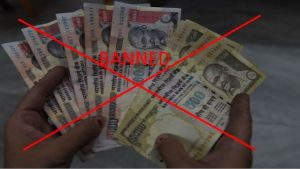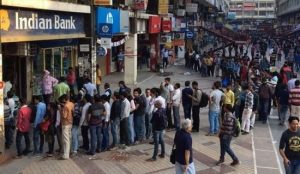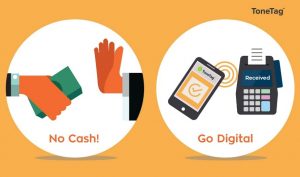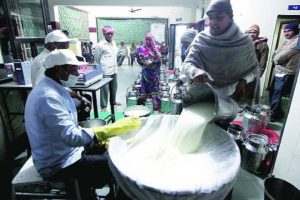Demonetization is the act of not recognizing the currency unit, in other words to remove the currency units from the money circulation system. It means to stop recognition of currency units as legal tender. It occurs whenever the existing notes and coins (currency units) are pulled from circulation from a country’s economy and gets replaced with new notes or coins. At times, a country completely replaces the old currency with new currency.
The opposite of demonetization is remonetization, in which the currency’s recognition as legal tender is restored.
A country goes for demonetization for reasons such as: to combat inflation, to combat corruption and crime, to counterfeit tax evasion, to reduce effects of cash-dependent economy, to facilitate trade etc.
It worth knowing that in the Coinage Act of 1873 related to mint in United States demonetized silver as the legal tender, and adopted the gold standard. Several coins, including two-cent piece, three-cent piece, and half dime were discontinued. The withdrawal of silver from the economy resulted in a retrenchment of the money supply, which subsequently led to a five-year economic depression throughout the country. In response to the dire situation and pressure from farmers and silver miners and refiners, the Bland-Allison Act remonetized silver as legal tender in 1878.
Another example of demonetization for trade purposes occurred when the nations of the European Union officially began to use the euro as their everyday currencies in 2002. When the physical euro bills and coins were introduced, the old national currencies, such as the German mark, the French franc and the Italian lira were demonetized. However, these varied currencies remained convertible into Euros at fixed exchange rates for a while to assure a smooth transition.
In 2015, the Zimbabwean government demonetized its dollar as a way to combat the country’s hyperinflation, which was recorded at 231,000,000%. The three-month process involved removing the Zimbabwean dollar from the country’s financial system and solidifying the U.S dollar, the Botswana pula and the South African rand as the country’s legal tender to stabilize the economy.
In India on 8th November 2016, Prime Minister Modi’s demonetization move certainly has some far reaching implications: some are and some bad.
Good Effects: the supply of black money approximately worth Rs.17 lakh crores stacked inside the country in various pockets is choked in one stroke and Rs.3 lakh crores in circulation is automatically flushed out. Black money operators run a parallel economy which always weakens the very foundation of an economy. With Modi’s demonetisation move, the black money will either be deposited into the banks with heavy penalty or simply will be destroyed.
The clean-up of illegal cash will help turn around the economy. First, it will bring more borrowings to the exchequer (national treasury) and improve inflation, and increase India’s gross domestic product (GDP). Second, it will revive investment opportunities and give a boost to infrastructure and the manufacturing sector. Third, it will help reduce interest rates and lower income tax rate.
It saw a great effect on the assembly elections in Uttar Pradesh, Punjab, Goa and Uttarakhand. It hampered the vote buying as the parties and politicians for whom black money used to be a lifeline, got a jolt. The election process got more cleaned and transparent. The political parties and politicians who were used to purchasing votes in exchange for notes, got a slap in their face.
The demonetization brought much needed correction in real estate industry. The industry is built on black money. The amount of black money in the sector is huge, the stroke of demonetization saw a dip in land and property prices!
It also slapped the hawala rackets. Hawala is a form of money laundering, which includes transferring money without any actual money movement. With demonetization the hawala operations have come to halt to a great extent. According to an India Today report, one of the hawala operators in Mumbai has destroyed currency notes worth about Rs 500 crores.
Fake notes in the circulation which devalues the real worth of currency got thundering halt. A study conducted by Indian Statistical Institute, Kolkata on behalf of the National Investigation Agency (NIA) suggests that fake Indian currency notes (FICN) amounting to Rs 400 crore are in circulation in the country at any given point of time and around Rs 70 crore fake notes are pumped into Indian economy every year. The most of the fake currencies circulated in India were of Rs 500 and Rs 1000 denominations.
This is an open secret that Pakistan has been printing fake Indian currency at its government printing press in Quetta and its security press in Karachi. The fake notes get funneled through the frontier at Jammu & Kashmir and via India’s permeable border with Bangladesh and Nepal. With the stroke of demonetization terror financing also is put to rest to some extent. Terror financing is sourced through counterfeit currency and hawala transactions.
The effects of Maoists and Naxalism slowed down because demonetization has hit their movements. They thrive on black money. It saw a positive effect even in Kasmir and North East insurgencies.
The Bad Effect: It made life harder for marginal and middle income workers. It made life of the real common people miserable. The laborers, micro business men, farmers who don’t have bank accounts suffered a lot. These vulnerable people felt that their money is worthless. Most dint even know that the money can be changed later. Many were strapped of their little savings in cash, as their old notes were taken at a discount. Farmers, fishermen, vegetable sellers, small shopkeepers without card readers or Paytm, taxi drivers, truckers, etc., have all been affected with loss of livelihood which may be irreparable in some cases, for example, loss of daily wages for casual labor, or lower sales for vegetable vendors.
Besides real-estate industry, sectors such as hotels, restaurants, catering, the fashion garments industry, entertainment, healthcare, leisure etc., which were often paid for in cash from black income also got affected. These are heavily cash-dependent.
People had to wait in queues for hours outside banks to withdraw their own hard-earned money. Limited supply of currency notes from the Reserve Bank of India (RBI) then and even today remains a challenge for managing cash dispensation. Banks do not receive adequate supply of notes and run out of cash at branches and automated teller machines (ATMs). Even ATM cash management companies say there is shortage of cash.
Prime Minister Narendra Modi wants India to be cash less economy.
The future of a cashless society: A cashless system brings down the transaction cost of printing, managing storing and transporting cash. The risk of money getting stolen or lost is almost zero. Cash is also untraceable, unaccountable, and easy to hide. It can be stolen or counterfeited. Cash feeds into the black money system, which brings down the money accountable to the nation. This reduces money laundering and increases tax compliance. The country would be benefitted with the money due to it. Criminal activities like illegal drug trade, illegal immigration, terrorism, human trafficking and corruption would be minimized as these activities run on cash transactions.
Truth: India lacks the infrastructure as of date. In the deep interiors of the nation access to banking facilities and opening accounts will take many years. In spite of Jan-Dhan accounts being opened, most of the accounts seem non-operational. Lack of literacy about available banking facilities is a big hindrance for such a system. A cashless system needs a strong online system to function. Again in the far and deep interiors of the country where people don’t have access to electricity, Internet availability and knowledge about technology is a delusion. As for online transactions, losing internet connection while transaction is being processed is a common complaint and hacking or being cheated by fake online portals is a big threat. India is still far away from being cashless.
Where there is will there is way – The Amul Story: Amul, the dairy cooperative jointly owned by 36 lakh milk producers in Gujarat has adapted cashless mode in a massive way. Since November 8th, 5.4 lakh farmers have opened their saving accounts in various banks. With this, almost 18 lakh milk producers are now getting their money directly into their bank account. It seems farmers are now saving a lot more by optimally planning their yearly financial goals, and with bank accounts, are able to get loans at a lesser interest rate. Now, the local moneylenders and sahukars – the so called loan sharks cannot cheat them, as the farmers used to get stuck within their high-interest trap, and end up spending more money. The response from farmers to open bank accounts has been immense. Earlier, they were spending money recklessly and had not developed the habit of saving. With their bank accounts now being operational and a withdrawal limit in place, milk farmers have seen an improvement in their savings too. They now prefer applying for house and car loans.

















































